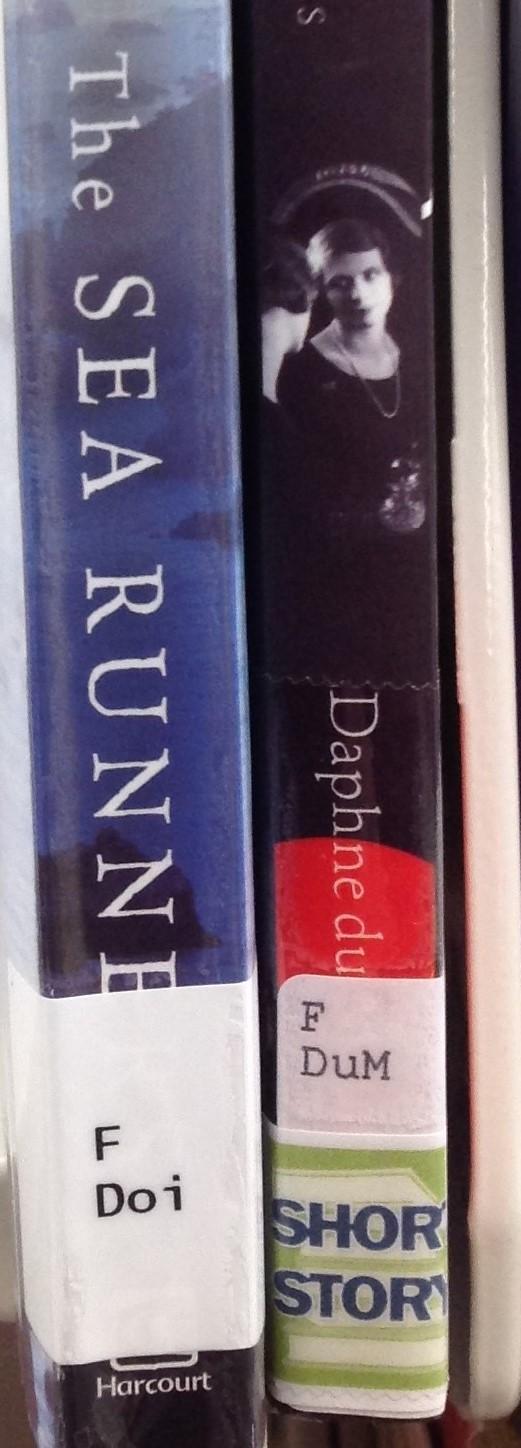Cataloging
General Fiction (10101)
| iCode | iType | Loan Rule | Loan Parameters | Call Number | Location | New Items on STAR? |
|---|---|---|---|---|---|---|
| 10101 | 95 | 67 | 21D YH YR $.10 | F ### | znaf | Yes. Use iType 82 and location znan. Add STAR to OPAC call number. |
What’s included:
- Popular fiction: Put here all fictional works (excluding poetry and plays) that aren’t more appropriately classed in mystery or science fiction. This includes westerns and romance novels (the only catch for these is that they shouldn’t be mass-market paperbacks — use the separate 10500 iCode and PB prefix for that format).
- Literary fiction: Include all novels and short story collections that are “serious” or have some kind of literary merit.
- Thrillers/suspense novels: The distinction between these works and mystery novels is fuzzy. As an easy starting point, look for a Detective and mystery fiction subject heading; it the record has one, put the book in 10106. Otherwise, some general tips: Aim to keep police procedurals, spy novels, and anything with a consistently dramatic, intense plotline in regular fiction. Look for a hero involved in espionage, law, or medicine, and description and dialogue that draws on jargon from his profession. To simplify things for patrons, keep together all works by writers operating hazily along the thriller/mystery line (either all in 10101 or all in 10106); be particularly diligent about this with writers on the Automatically Yours list. Break this preference for location consistency only when an author associated with a particular genre releases a book that clearly belongs somewhere else. For example, most of James Patterson’s novels are in mystery, but some, like this one about a middle-aged golfer with family and work problems, are definitely straight fiction. John Grisham tends to write mysteries, too, but has a few that are in 10101.
- Some books with elements of fantasy: For example, Margaret Atwood, Diana Gabaldon, Stephen King, J.R.R. Tolkien are in 10101. Works like theirs tend to have more literary or historical fiction associations that warrant F over SF, but there’s no hard and fast rule. If an incoming novel seems labeled incorrectly, just double-check with the CM head.
- Horror: Because horror novels rely on fear, suspense, and a confrontation with the unknown as the core elements driving their plotlines, all horror titles are thriller titles – and so could be shelved in F. The tricky part comes when a story has some futuristic element or an aspect of the occult as its source of tension. Some guidelines: put in F any “scary” novel with (a) Horror fiction as its only genre heading (as opposed to something like Fantasy fiction), (b) few or no supernatural elements, or (c) a more literary style. Sample works include Dracula, Frankenstein, and Dr. Jekyll and Mr. Hyde.
- Collaborations: Shelve single works of fiction created jointly by more than one person in 10101, not the 800s. Use the person credited in the 100 field for the spine label. For example, Beatriz Williams, Lauren Willig, and Karen White collaborated on the novel The glass ocean. Williams is listed in the 100 field. The book is in 10101 under F Wil.
- Anthologies of works by a single author: Collections of works by an individual author go in F. These can be comprised of short stories and/or longer works. Reserve the 800s for anthologies of writings by multiple authors.
What’s not included:
- Mystery and science fiction novels: To ID these, look for Detective and mystery fiction or Fantasy fiction genre headings. Use this as a starting point, not as a fail proof method. See the notes above as well as the SF and M pages for more criteria.
- Shakespeare: Texts of his plays and literary critiques of them go in the 800s.
- Most literary anthologies and some experimental fiction: Collections of works by more than one writer go in the 800s. The latter category is a fuzzier area; we’ve got some genre-bending works – titles that play with fact and fiction – in the 800s as opposed to F or BIO. Take a title-by-title approach: watch the Bib Deweys, B&T spines, and make a judgment call on which area is best.
Spine label and other info:
-
- Add a short story sticker to the spines of short fiction collections. Do not use any other stickers for books in 10101.
- Older titles just being published in English for the first time go to new shelving (znan) after initial processing.
- For series that have been picked up by a new writer after the original creator died/stopped writing it, use the lettering on the cover to determine which author to use in the call number. If the original author has received top billing, use that author’s name. For example, in one of the Tom Clancy series, Tom Clancy’s Op-Center: Dark Zone appears in large type on the cover, while the actual author of the book, Jeff Rovin, is credited in smaller type below. Use F Cla for the spine. Sample MARC data is below. See the Naming Conventions page for images.
EXAMPLE 1:
100 field: |aRovin, Jeff, |eauthor.
245 field: |aTom Clancy’s Op-Center. |pDark zone / |ccreated by Tom Clancy and Steve Pieczenik ; written by Jeff Rovin and George Galdorisi.
700 field: |aClancy, Tom, |d1947-2013, |ecreator.
Spine label: F Cla
Item record call number field: F Clancy
EXAMPLE 2:
100 field: |aLagercrantz, David, |eauthor.
245 field: |aThe girl in the spider’s web |cDavid Lagercrantz ; translated from the Swedish by George Goulding.
700 field: |aLarsson, Stieg, |d1954-2004.
Spine label: F Lag
Item record call number field: F Lagercrantz
ITEM RECORD

SPINE LABELS
